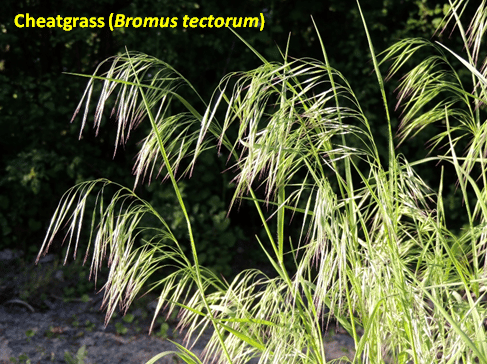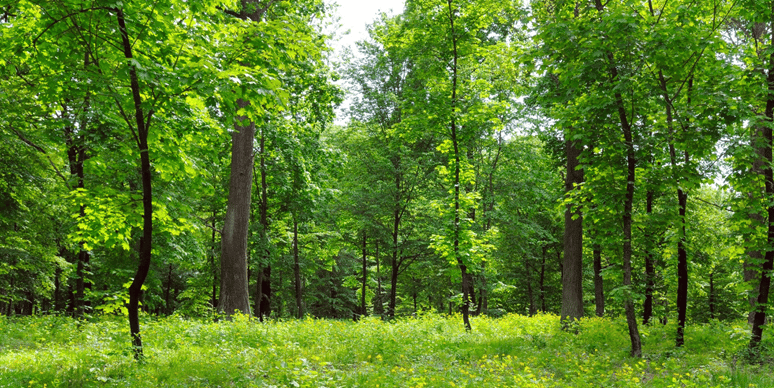Forests occupy one-third of our land area and play an important part in sustaining life on earth.Forests and their ecosystems help stabilize climate, regulate the water cycle, and provide food and shelter for thousands of life forms. All these benefits are collectively referred to as ecosystem services for which the forest understory is important. However, they are under threat from invasive plant species.
The forest ecosystem
There are three distinct layers that make up a forest ecosystem. These are:
- Forest canopy layer – this is the top part of the forest where trees photosynthesize and power the forest’s rapid growth.
- Forest understory layer – this is the layer below the canopy that is sheltered from intense sunlight. It is dark and gloomy and shielded from intense weather that is above the canopy.
- Forest floor layer– this is a layer which is occupied bacteria, fungi, insects, and a variety of other microorganisms that rapidly decompose organic matter and recycle nutrients for use by other organisms.
Combined, the layers of the forest ecosystem work together to provide important ecosystem services
What are ecosystem services?
Ecosystem services are the direct and indirect contributions of ecosystems to human wellbeing and have an impact on our survival and quality of life. For example:
- Regulating climate extremes
- Enhancing air and water quality
- Preventing soil erosion
- Cycling nutrients
- Making rain and providing agricultural support
- Sequestering carbon
Therefore, protecting forests, particularly forest understories, we help safeguard the ecosystem services that sustain life on earth.
The importance of the forest understory
In addition to providing ecosystem services, the forest understory is an important source of food and medicine. For example,
- Many of our popular foods and beverages, such as bananas, cocoa, coffee, and cinnamon, were originally plants of the forest understory. Today, the forest understory provides us with edible roots and tubers, grains, fruits, resins, gums, honey, edible fungi, and food for our livestock.
- Many species of shrubs and small trees in the forest understory have medicinal properties. For example, American ginseng, black cohosh, bloodroot, and goldenseal.
Threats to the forestry understory
In the past several years, forest fires have become common occurrences in the United States. When forest fires occur, they often do irreparable damage to the entire forest ecosystem. However, forest fires are not the major threat to the forest understory.
According to the USDA Forest service, the most significant threat to forest ecosystems is forest understory habitats that have been invaded and dominated by invasive nonnative plant species. They have identified several invasive plant species that are linked to the increase in forest fires. For example:
Cheatgrass (Bromustectorum) – a herbaceous annual plant species that is native to Europe and was introduced to the United States in wheat shipments. Cheatgrass has invaded several forest understory habitats following disturbances, like logging, which opened the tree canopy allowing the invasion by this grass species. Once it becomes established, cheatgrass provides fuel for wildfires.


Tree-of-heaven (Ailanthisaltissima) – a small hardwood plant that was introduced to the United States as an ornamental species and later became a noxious invasive tree species. It spreads aggressively by seed or vegetatively and it exudes allelochemicals into the soil which limit or prevent the establishment of other plant species.
Preventing the establishment of invasive plant species must be prioritized if we are to maintain the ecosystem services of forest understory habitats.
How do nonnative invasive plant species behave?
Nonnative invasive plant species can sneak into a habitat undetected, and they usually become recognized once they are established. Prior knowledge of invasiveness in other regions is helpful as is constant monitoring of the forestry understory. Furthermore, because invasive plant species try to dominate a habitat, ensuring high levels of ecosystem biodiversity is necessary.
Presently, information is available for some plant species that are invasive or have traits that have been scientifically identified as being invasive. Information on invasive plant species of forest understories can be obtained from the extension services of state land grant universitieswith forest departments or from the USDA Forest Service.
Steps in controlling invasive plant species in the forestry understory
- Identify the invasive plant, its growth habits, and life cycle. Knowledge of the growth habits and life cycle will provide information that can be used to target vulnerable plant stages for maximum control of the invasive plant species.
- Select a control technique. For example,
- Using selective herbicides that can control the invasive species without causing damage to non-targeted species.
- Use a specific technique like basal spray applications to small hardwood plants using a handheld or backpack sprayer.
- Select an appropriate adjuvant to enhance control with herbicide. For example,
- Use Cide Kicknonionic surfactant toenhance the ability of the herbicide to penetrate the leaf surface and improve control.
- Use JLB Oil Plus nonionic surfactant to enhance herbicide penetration of the bark and improve control of small hardwood plants.
- Evaluate the effectiveness of control with herbicide two to four weeks after application. Repeat applications if needed and if possible. This is an important step in staying a step ahead of invasive plant species.
Invasive plant species can damage the forest ecosystem by altering the composition of plant species. Mitigating the impact of invasive plants in forest ecosystems:
- Helps sustain our source of food, medicinal plants, and the ecosystem services that sustain our livelihoods.
- Reduces the amount of fuel for forest fires.
Further Reading:
- Facts To Know About Forestry Understory Management
- Basal Bark Treatment: What is it and how is it used?
- JLB Oil Plus: Combating Problematic Woody Plant Species
- Cide-Kick II for Excellent Management of Weedy and Invasive Plants
- Adjuvants 101: Nonionic Surfactants
- The Importance of Forest Vegetation Management
References
- Pearce, R. 2020.What are Ecosystem Services? [Accessed, November 29, 2022].
- Jackson, D.R. and Finley, J. 2007. Herbicides and Forest Vegetation Management. [Accessed, November 29, 2022].
- Arnett, E. 2020. This Invasive Species is Fueling Western Wildfires. [Accessed, November 29, 2022].
- National Park Service, US Dept. of the Interior. 2015. Fire and Invasive Weeds Resource Brief. [Accessed, November 29, 2022].
Brewer International has been a leader in land and water chemistry since the 1980s and for over 40 years has proudly served its national and regional distributors.
Our products are used widely across the United States in agriculture, aquatics, forestry, rights of way, and land management.
Our customers trust our dedication to quality ingredients, tried and true formulas, and positive outcomes.


